
Radha, also called Radhika, is a Hindu goddess and the chief consort of the god Krishna. She is the goddess of love, tenderness, compassion, and devotion. In scriptures, Radha is mentioned as the avatar of Lakshmi and also as the Mūlaprakriti, the Supreme goddess, who is the feminine counterpart and internal potency of Krishna. Radha accompanies Krishna in all his incarnations. Radha's birthday is celebrated every year on the occasion of Radhashtami.
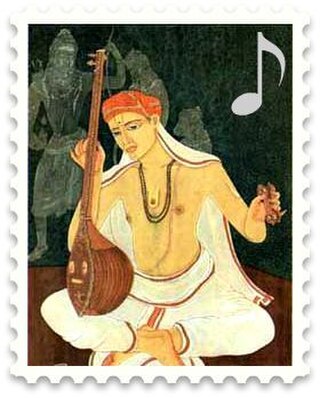
Thumri is a vocal genre or style of Indian music. The term "thumri" is derived from the Hindi verb thumuknaa, which means "to walk with a dancing gait in such a way that the ankle-bells tinkle." The form is, thus, connected with dance, dramatic gestures, mild eroticism, evocative love poetry and folk songs, especially from Uttar Pradesh, though there are regional variations.

Holi is a popular and significant Hindu festival celebrated as the Festival of Colours, Love, and Spring. It celebrates the eternal and divine love of the deities Radha and Krishna. Additionally, the day signifies the triumph of good over evil, as it commemorates the victory of Vishnu as Narasimha over Hiranyakashipu. Holi originated and is predominantly celebrated in the Indian subcontinent of India and Nepal, but has also spread to other regions of Asia and parts of the Western world through the Indian diaspora.
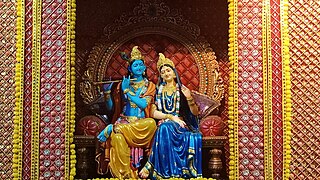
Braj, also known as Vraj, Vraja, Brij or Brijbhumi, is a region in India on both sides of the Yamuna river with its centre at Mathura-Vrindavan in Uttar Pradesh state encompassing the area which also includes Palwal, Ballabhgarh and Nuh in Haryana state, Deeg, Bharatpur, Karauli, and Dholpur in Rajasthan state and Morena District in Madhya Pradesh. Within Uttar Pradesh, it is very well demarcated culturally, the area stretches from the Mathura, Aligarh, Agra, Hathras and districts up to the Farrukhabad, Mainpuri and Etah districts. Braj region is associated with Radha and Krishna who according to scriptures were born in Barsana and Mathura respectively. It is the main centre of Krishna circuit of Hindu pilgrimage.
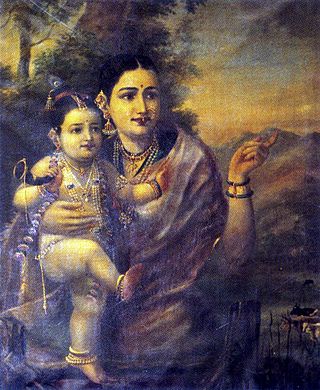
Krishna Janmashtami, also known simply as Krishnashtami, Janmashtami, or Gokulashtami, is an annual Hindu festival that celebrates the birth of Krishna, the eighth avatar of Vishnu. In certain Hindu texts, such as the Gita Govinda, Krishna has been identified as supreme God and the source of all avatars. Krishna's birth is celebrated and observed on the eighth day (Ashtami) of the dark fortnight in Shravana Masa or Bhadrapada Masa. This overlaps with August or September of the Gregorian calendar.

Uttar Pradesh is a state of India. The region's folk heritage includes songs called rasiya, which celebrate the divine love of Radha and Shri Krishna. These songs are played by large drums known as bumb, and are performed at many festivals.
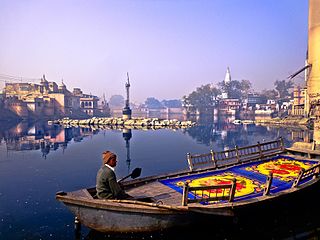
Mathura district situated along the banks of the river Yamuna is a district of Uttar Pradesh state of north-central India. The historic city of Mathura is the district headquarters. Mathura district is home to many important sites associated with goddess Radha and Lord Krishna, who was born in Mathura and grew up in the nearby town of Vrindavan. Both cities are some of the most sacred sites in the Vaishnava tradition, making Mathura district an important Hindu pilgrimage centre.
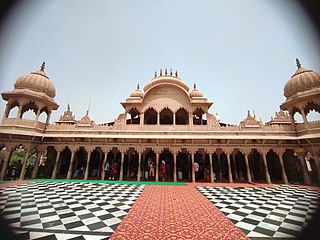
Barsana is a historical town and nagar panchayat in the Mathura district of the state of Uttar Pradesh, India. The town holds cultural and religious significance as the birthplace of Hindu goddess Radha, the chief consort of Krishna. Barsana is situated in the Braj region. The main attraction of the town is the historical Radha Rani Temple which attracts huge number of devotees throughout the year.

Radha Kund is a town and nagar panchayat in Vrindavan in the Indian state of Uttar Pradesh. It is also one of the pilgrimage sites dedicated to Hindu goddess Radha.

Radha Ramana is one of the combined forms of the Hindu deities Radha and Krishna, besides their BankeBihari and Radha-Vallabha forms.

The Culture of Uttar Pradesh is an Indian culture which has its roots in Hindi, Bhojpuri and Urdu literature, music, fine arts, drama and cinema. Lucknow, the capital of Uttar Pradesh, has historical monuments including Bara Imambara and Chhota Imambara, and has preserved the damaged complex of the Oudh-period British Resident's quarters, which are being restored.

Rasiya is a popular genre of Indian folk music from the Braj region of Uttar Pradesh. The style of rasiya consists of multiple sub genres and is performed in a variety of different contexts. The songs have been known to portray a wide range of topics however, they are most commonly sung to a set of stock tunes that often portrays the love of the Hindu god Krishna and goddess Radha. The term rasiya is the Hindi word for “epicure” which refers to the male suitors, or the god Krishna himself as depicted in the songs. Rasiya's are sung and typically played with a variety of instruments, the most common are the “dholak” drums, sarangi, and harmonium. This style of music is commonly associated with the popular ancient Hindu festival of Holi and is often performed by villagers, professional entertainers, as well as participants in temple song sessions.
Haveli Sangeet is a form of Hindustani classical music sung in havelis. The essential component is dhrupad. It originated in Mathura in Braj, northern India. It takes the form of devotional songs sung daily to Krishna by the Pushtimarg sect.

Kusum Sarovar is a sacred water reservoir with a historic sand monument in its backdrop. It is situated on the holy Govardhan Hill between Manasi Ganga and Radha Kund in Mathura district of Uttar Pradesh, India. Kusum Sarovar is considered one of the sacred spots that witnessed the pastimes of Hindu deities Radha and Krishna. It is also the place of Jat ruler Maharaja Suraj Mal's memorial chhatri. Kusum Sarovar has Narada Kund, where Bhakti Sutra verses were written by Narada and the Shri Radha Vana Bihari Temple in the vicinity.
Geetanjali Sharma is an Indian Folk exponent and a Kathak dancer. She is the disciple of Uma Dogra, the senior disciple of Pt. Durga Lal who was the Kathak maestro from Jaipur Gharana. She has been performing dance in India and abroad for more than 24 years.

Shri Radha Rani Temple, is a historical Hindu temple, located in Barsana in Mathura district, Uttar Pradesh, India. The temple is dedicated to the goddess Radha. The main deities of the temple are Radha Krishna who are worshipped together in the form of Shri Laadli Lal which means beloved daughter and son of the town.

Radha Krishna Vivah Sthali is a Hindu temple dedicated to Radha and Krishna. The temple site is present in the Bhandirvan forest of Mant constituency in Mathura district, Uttar Pradesh, India. The site holds cultural importance as according to Sanskrit scriptures - Braham Vaivarta Purana and Garga Samhita, Radha and Krishna were married in Bhandirvan forest in the presence of Brahma, the creator, who also became the priest and solemnized their wedding ceremony. Annually, this divine wedding is celebrated on the occasion of Phulera Dooj which usually falls in the month of February - March.

Shri Radha Madan Mohan Temple, is a Hindu temple situated in Vrindavan of Indian state of Uttar Pradesh. It is one of the oldest and highly revered temple of Vrindavan. The presiding deity of the temple is Madan Mohan, a form of the god Krishna who is present in the central altar of the temple with his consort goddess Radha and Lalita gopi on either sides of him.
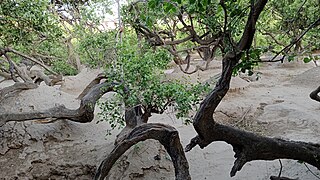
Nidhivan, is one of the sacred sites of Vrindavan, situated in the Mathura district, Uttar Pradesh, India. It is considered as the most prominent site dedicated to the pastimes of the Hindu deities Radha and Krishna and their cowherd companions, the Gopikas. It is a common belief among devotees that Nidhivan still witnesses the rasa-lila (dance) of Radha and Krishna during the night and thus, to protect the forest's sanctity, Nidhivan is closed with barricades during the night.

The Ashtasakhi are a group of eight prominent gopis and close associates of the Hindu deities Radha-Krishna in the Braj region. In many sub-traditions of Krishnaism, they are revered as goddesses and consorts of Krishna. According to the Padma Purana, the Ashtasakhi are the eternal female companions of Radha-Krishna in the Dvapara Yuga, with whom they descended upon the earth from their celestial abode of Goloka.
















